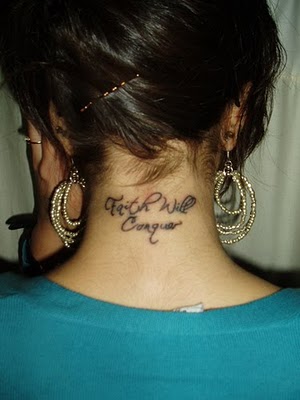
cross tattoos for women neck image

Andrea
I can't decide where on my body to get these tattoo's done. I'm getting a good sized flower (but its not a stupid one, its really pretty... i hear someone say they are getting a flower tattoo and i think 'why something so stupid?' but i've found one i really like). Also i'm going to get a cross and then falling stars or shooting stars. its my christmas present to me. where should they go? where should i go!? i live near detroit... any suggestions?
Answer
Center the flower on the small of your back.
Put the cross just about where a cross would rest if it were hanging off a chain and the shooting star could go across your right shoulder, aimed at your neck.
Question about spies and concentration camps during WWII?

G.P.
Hello, I am writing a movie script and I have a couple of questions about the holocaust in WWII.
1. Would a captured spy ever be sent to a concentration camp?
2. And how would the numbers on the forearms be assigned?
Thanks in advance!
Answer
The execution of women by the Nazis
Among the most notable resistance movements were the Yugoslav Partisans, the Polish Home Army, the Soviet partisans (at varying periods, each of them could be seen as the largest resistance movement in World War II),[a] the French Forces of the Interior, the Italian CLN, the Norwegian Resistance, the Greek Resistance and the Dutch Resistance.
en.wikipedia.org/wiki/Resistance_during_World_War_II
Since they were partisans the custom was to execute them immediately in the field so tattoos were unnecessary, that was done only in the camps and these executions were carried out in the field. This is a tribute to the amazing courage of so many young women during World War II who were put to death for plotting and fighting against the Nazis, as resistance fighters, partisans and activists in towns and concentration camps.
It is estimated that more than 4,000 women of various ages were hanged by Nazi forces between 1939 and 1945. Many more were shot or guillotined and many were tortured before minimal or non-existent trials. They could be sentenced to death by People's Courts and executed within prisons, by the commandants of concentration camps or by military commanders in the field and summarily executed, usually in public. Some of these "field" executions were documented and photographed. A lot of the photographs were private snaps taken by individual soldiers and discovered after they had been captured or killed. Hanging was the preferred method for the execution for partisans as it produced more of a public spectacle than shooting and was used to terrorize the local populace as well as entertain the troops. Guillotining within prisons was used for German citizens convicted of treason and other offenses after trial by the People's Courts.
Executions in the field.
A gallows was used when the Nazis wanted to make a particular example of the prisoner and these were usually crude and simple structures that did not have a trapdoor or drop. They typically consisted of just a post with a short beam projecting from the top cross braced to the upright. Trees or balconies were also used as was any other structure that was available, e.g. the roof beams of a barn.
Prisoners were never hooded and rarely blindfolded. Their hands were normally tied behind their backs with cord but their legs usually left free. They were given little or no drop, partially to prolong the pleasure of the soldiers and because their cruel and slow deaths would act as a stronger deterrent to the local people who were often made to witness the event. Typically a thin rope was used, fashioned into a simple slip knot. It was not unusual for prisoners to kick and struggle after suspension and to lose control of their bladders and bowels. The bodies could be left hanging for several days as a grim reminder to others. In cold weather, they were sometimes left hanging for a week while in summer they would be taken down sooner, perhaps two to three hours after the hanging.
This is a very short list of Polish partisans executed during the Holocaust. There were many more in other occupied countries. Masha Bruskina, Klava Nazarova, Maria Kislyak, Lepa Radic, Zoya Anatolyevna Kosmodemyanskaya, Vera Voloshina, Mala Zimetbaum, Roza Robota, Ala Gertner, Lilo Hermann, Mildred Harnack, Eva-Marie Buch, Cato Bontjes Van Beek, Elizabeth Gloeden, Gertrud Seele, Ilse Stöbe, Sophie Scholl â guillotined in Munich, Baroness Benita von Falkenhayn and her friend Renate von Natzner , who were convicted of spying and beheaded by the executioner, Carl Gröpler, on the 18th of February 1935.
Guillotinings could be carried out at three minute intervals. Hangings were notably cruel, the prisoner was led in with their hands tied behind them and made to get up onto the two step step-up, the executioner following them and placing the thin cord slip knot around their neck. They were not hooded or blindfolded. The executioner got down and simply pulled the step-up from under them leaving them suspended with little or no drop.
gatita
Degree in History (focus Jewish studies) and Spanish, New Mexico State U. 1990
Powered by Yahoo! Answers

